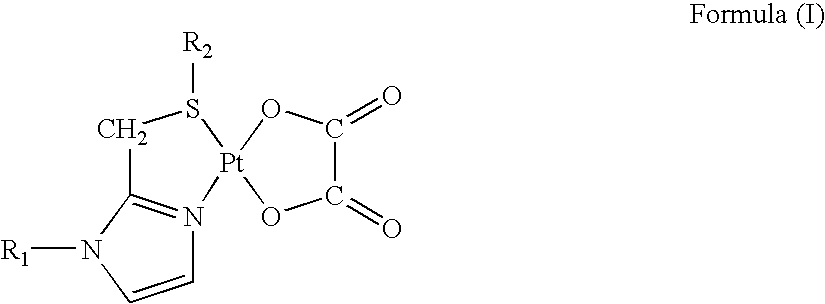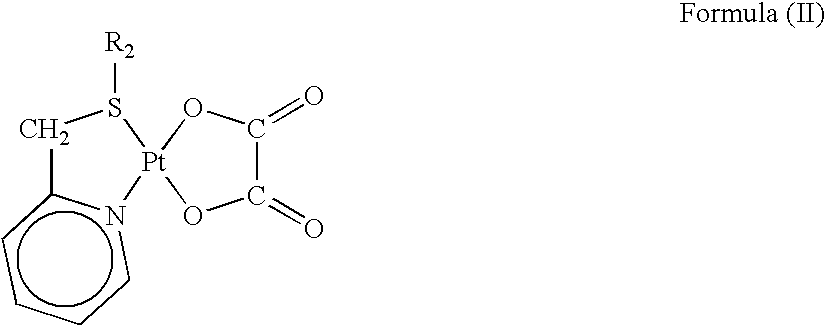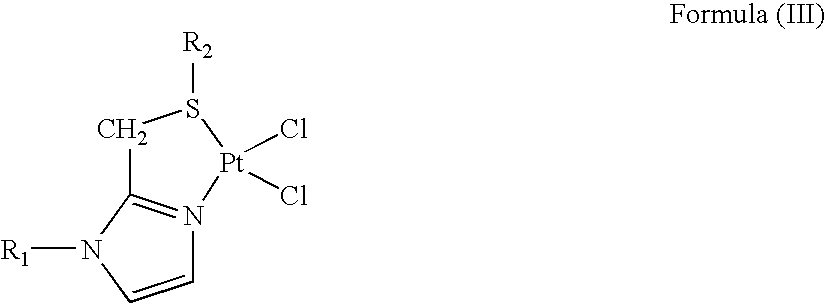Preparation of Platinum(II) Complexes
a technology of complexes and platinum, applied in the field of platinum complexes, can solve the problems of complex multi-step pathways, many impurities incorporated into products,
- Summary
- Abstract
- Description
- Claims
- Application Information
AI Technical Summary
Problems solved by technology
Method used
Image
Examples
example 1
[0133] This example shows a method for preparing optically pure Pt(trans-l-1,2-diaminocyclohexane)Cl2 which is an intermediate compound in the process of the present invention.
[0134] Trans-1,2-diaminocyclohexane (5.70 g, 50 mmol) is dissolved in water (10 mL). l-artaric acid (3.75 g, 25 mmol) is added incrementally to the solution while continuously stirring and once completely added to the solution, the mixture is heated to 90° C. When all the tartaric acid is dissolved, glacial acetic acid (5 mL, 85 mmol) is added dropwise while stirring. The mixture is heated for 1 hour at 90° C. whereafter it is cooled to room temperature. The resultant white l-1,2-diaminocyclohexane-l-tartrate is filtered and washed twice with cold water (5 mL), 3 times with methanol (5 mL) and oven dried. The salt is recrystallized out of hot water and cooled overnight at 5° C.
[0135] The recrystallized l-1,2-diaminocyclohexane-l-tartrate (18.9 g, 72.62 mmol) is added to 4 equivalents of sodium hydroxide (11....
example 2
[0137] This example shows a first embodiment of the invention for producing oxaliplatin by reacting a halogenoplatinum(II) complex containing a neutral bidentate ligand, with a metal oxalate in a mixed solvent system.
[0138] Optically pure Pt(trans-l-1,2-diaminocyclohexane)Cl2 (0.508 g, 1.3 mmol) was dissolved in dmf (93 mL) at 90° C. The solvent ratio was adjusted to 87:13 dmf:water by adding 14 mL water. One equivalent of cesium oxalate (0.508 g, 1.3 mmol) was dissolved in 4 mL of solvent containing 1 mL dmf and 3 mL water. This solution was added drop-wise while stirring to the yellow Pt(trans-l-1,2-diaminocyclohexane)Cl2 solution. The reaction mixture was stirred continuously for 6 hours at 90° C. in a closed system containing a nitrogen atmosphere after which the solvent was removed by vacuum. The resultant light yellow solid was washed (4 times) with small portions (4 mL) of cold water. The residual solid was suspended in water for 10 minutes at 70° C. The solution was filtere...
example 3
[0139] This example shows a first embodiment of the invention for producing oxaliplatin by reacting a halogenoplatinum(II) complex containing a neutral bidentate ligand, with a metal oxalate In a mixed solvent system.
[0140] Optically pure Pt(trans-l-1,2-diaminocyclohexane)Cl2(1.017 g, 2.68 mmol) was dissolved in dmf (176 mL) at 90° C. whereafter 17 mL water was added. One equivalent of cesium oxalate (0.947 g, 2.68 mmol) was dissolved in 13 mL of solvent containing 3 mL dmf and 10 mL water. This solution was added drop-wise while stirring, to the yellow Pt(trans-l-1,2-diaminocyclohexane)Cl2 solution. The overall solvent ratio achieved at this point was 87:13 (dmf:water). The reaction mixture was stirred continuously for 4 hours at 90° C. in a closed system containing a nitrogen atmosphere whereafter another equivalent of cesium oxalate dissolved in 10.6 mL solvent, containing 2.6 mL dmf and 8 mL water, was added drop-wise. More water (30 mL) was added to change the solvent ratio to...
PUM
| Property | Measurement | Unit |
|---|---|---|
| temperature | aaaaa | aaaaa |
| temperature | aaaaa | aaaaa |
| solubility | aaaaa | aaaaa |
Abstract
Description
Claims
Application Information
 Login to View More
Login to View More - R&D
- Intellectual Property
- Life Sciences
- Materials
- Tech Scout
- Unparalleled Data Quality
- Higher Quality Content
- 60% Fewer Hallucinations
Browse by: Latest US Patents, China's latest patents, Technical Efficacy Thesaurus, Application Domain, Technology Topic, Popular Technical Reports.
© 2025 PatSnap. All rights reserved.Legal|Privacy policy|Modern Slavery Act Transparency Statement|Sitemap|About US| Contact US: help@patsnap.com



